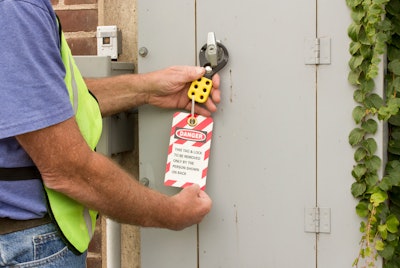
 iStock
iStock
Ensure you complete a risk assessment
A risk assessment should be completed on site before any workers enter the premises. The aim of the risk assessment is the identify any and all risks to people as well as the severity of the injury that could be caused. It should take into consideration the type of electrical equipment used, how it is used and the environment that it is used in. Risk assessments are made up of five stages[1] that must be completed to ensure safety:
- Identify any electrical hazards and the electrical system or process
- Identify the electrical work to be performed within the electrical system
- Evaluate the risks and decide on precautions to take
- Record your findings and implement them
- Review the risk assessment and update when necessary
Complete the lockout/tagout procedure
 Reece Safety
Reece Safety
The Occupational Safety and Health Administration (OSHA) requires a formal lockout/tagout program to be in place where industrial machinery is used, to ensure that employees are always working in a safe environment and should be diligently followed. All workers who use machinery should be thoroughly trained on the lockout/tagout program before beginning work, as well as being provided with the correct lockout tagout equipment, such as that from Reece Safety. This procedure has since developed into lockout/tagout tryout (LOTOTO), with emphasis on trying to restart the equipment, which checks that the lockout/tagout procedure has been successful.
Don’t overload your outlets
The use of electrical adapters can often mean more power to electrical machines and technology; however, this is not always safe, particularly in a busy and crowded working environment that tradespeople often work in. If using extension leads, ensure that the appliances or tools plugged into the outlets do not exceed the maximum current rating stated for the extension lead. If power outlets are overloaded, this could lead to overheating and/or fire.
Ensure you use safety signage
Safety signs are needed to help warn people of hazards as well as indicate or prohibit actions. They are very useful in preventing injury, for example, warning and danger signs should always be positioned within proximity of the equipment – not only for the benefit of workers, but for the safety of visitors and contractors who may visit the site. There are four types of safety signs that should be included within your workplace’s health and safety program: prohibition and fire (red), mandatory (blue), caution and safe condition. For electrical hazards and fire hazards, yellow ‘danger’ signs are used to identify electric shock risks, fire risks and hazards.
Maintain your equipment
This tip is essential to keeping machinery, tools and equipment healthy and safe for as long as possible without needing repair. Machines and equipment should always be checked for wear and tear, with regular services and cleans being performed in order to keep them running smoothly, which will also decrease the chance of machinery breaking down or malfunctioning. There are several ways to maintain large equipment and machinery, including adding and testing lubricants frequently, which will not only extend the life of your machinery but will also remind you to check for build-up or excess oil and leaks around seals. By checking for signs of wear as a machine is used, you are less likely to suffer any electrical issues and injury to workers without spotting the warning signs first.
[1] https://www.rospa.com/rospaweb/docs/campaigns-fundraising/hse-five-steps-to-risk-assessment.pdf






















